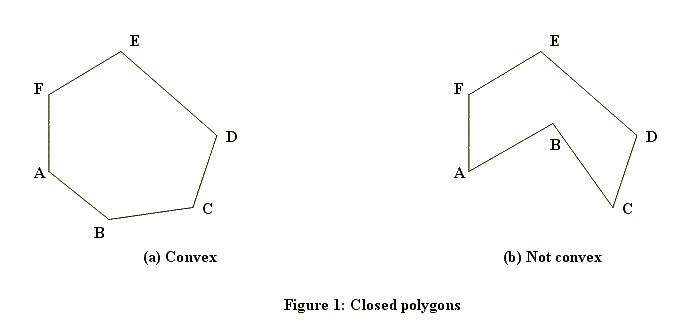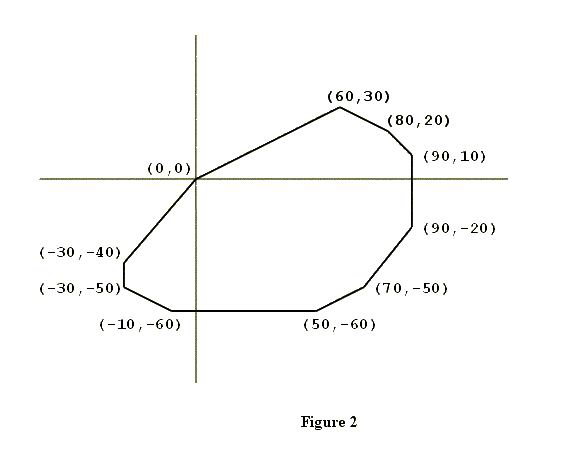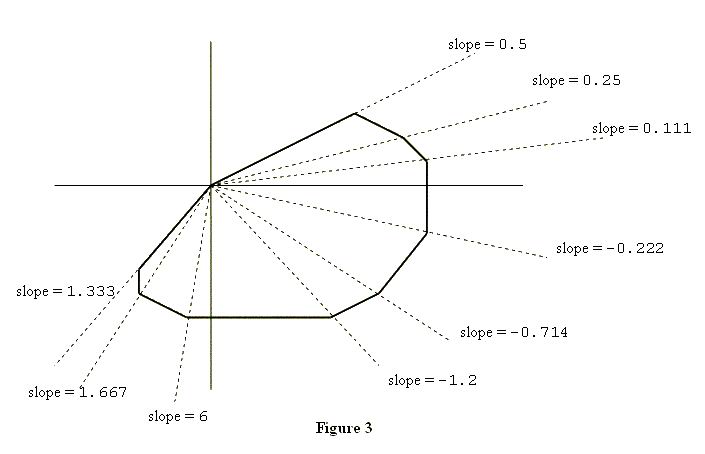| Time Limit: 1000MS | Memory Limit: 30000K | |
| Total Submissions: 7568 | Accepted: 3604 |
Description



Input
Output
Sample Input
0 0 70 -50 60 30 -30 -50 80 20 50 -60 90 -20 -30 -40 -10 -60 90 10
Sample Output
(0,0) (-30,-40) (-30,-50) (-10,-60) (50,-60) (70,-50) (90,-20) (90,10) (80,20) (60,30)
Source
题意:给出若干个点,求出它们的凸包,并且按原点为第一点的逆时针方向输出。
#include<cstring>
#include<iostream>
#include<cstdio>
#include<algorithm>
#include<cmath>
#include<vector>
#define PI 3.1415926
const double eps=1e-12;
#define _sign(x) ((x)>eps?1:((x)<-eps?2:0))
using namespace std;
const int MAXN = 1010;
struct Point {
double x,y;
Point() {}
Point(double _x,double _y) {
x = _x;
y = _y;
}
Point operator -(const Point &b)const {
return Point(x - b.x,y - b.y);
}
//叉积
double operator ^(const Point &b)const {
return x*b.y - y*b.x;
}
//点积
double operator *(const Point &b)const {
return x*b.x + y*b.y;
}
//绕原点旋转角度B(弧度值),后x,y的变化
void transXY(double B) {
double tx = x,ty = y;
x = tx*cos(B) - ty*sin(B);
y = tx*sin(B) + ty*cos(B);
}
};
Point L[MAXN];
int Stack[MAXN],top;
int n;
double m;
double dist(Point a,Point b) {
return sqrt((a.x-b.x)*(a.x-b.x)+(a.y-b.y)*(a.y-b.y));
}
int sgn(double x) {
if(fabs(x)<eps)return 0;
if(x<0)return -1;
return 1;
}
//相对于L[0]的极角排序
bool _cmp(Point p1,Point p2) {
double tmp = (p1-L[0])^(p2-L[0]);
if(sgn(tmp) > 0)return true;
else if(sgn(tmp) == 0 && sgn(dist(p1,L[0]) - dist(p2,L[0])) <= 0)
return true;
else return false;
}
void Graham(int n) {
Point p0;
int k = 0;
p0 = L[0];
//找最下边的一个点
for(int i = 1; i < n; i++) {
if( (p0.y > L[i].y) || (p0.y == L[i].y && p0.x > L[i].x) ) {
p0 = L[i];
k = i;
}
}
swap(L[k],L[0]);
sort(L+1,L+n,_cmp);
if(n == 1) {
top = 1;
Stack[0] = 0;
return;
}
if(n == 2) {
top = 2;
Stack[0] = 0;
Stack[1] = 1;
return ;
}
Stack[0] = 0;
Stack[1] = 1;
top = 2;
for(int i = 2; i < n; i++) {
while(top > 1 && sgn((L[Stack[top-1]]-L[Stack[top-2]])^(L[i]-L[Stack[top-2]])) <= 0)
top--;
Stack[top++] = i;
}
}
int main() {
//freopen("test.in","r",stdin);
n=0;
while(~scanf("%lf%lf",&L[n].x,&L[n].y)) {
n++;
}
Graham(n);
double ans=0;
int p=0;
for(int i=0; i<top; i++) {
int u=Stack[i];
if(L[u].x==0&&L[u].y==0) {
p=i;
break;
}
}
for(int i=p; i<top; i++)
printf("(%.0f,%.0f)\n",L[Stack[i]].x,L[Stack[i]].y);
for(int i=0; i<p; i++) {
printf("(%.0f,%.0f)\n",L[Stack[i]].x,L[Stack[i]].y);
}
return 0;
}版权声明:本文为博主原创文章,未经博主允许不得转载。
POJ 2007 Scrambled Polygon(凸包)
原文地址:http://blog.csdn.net/acm_baihuzi/article/details/47430595